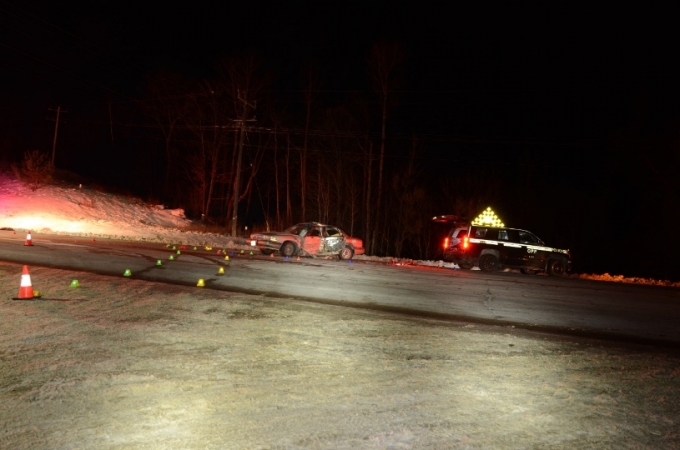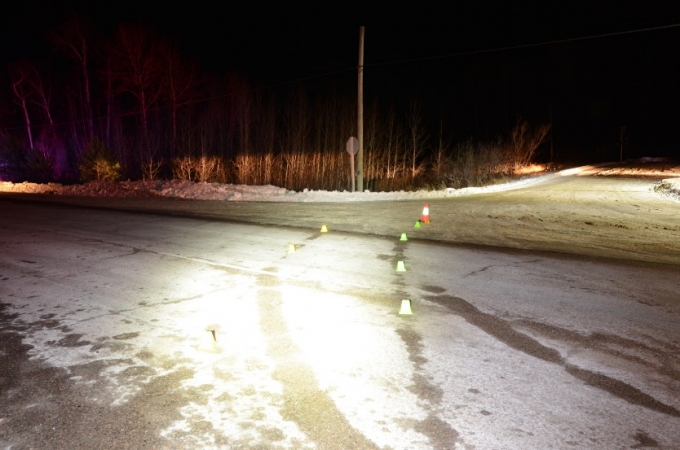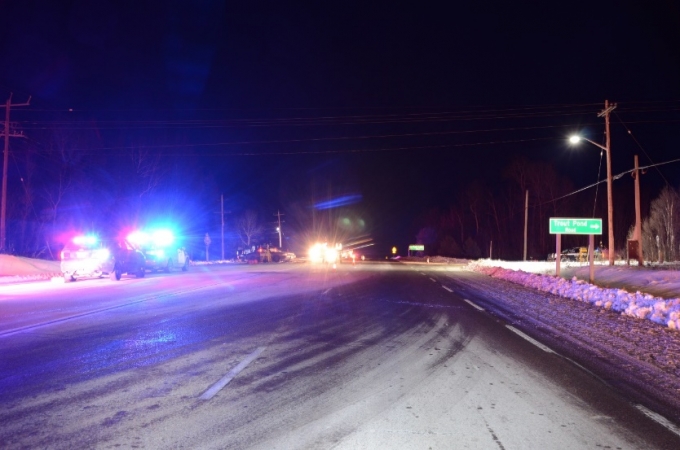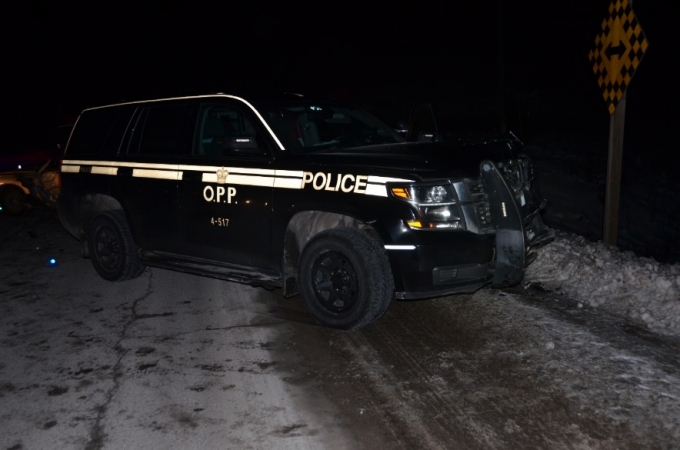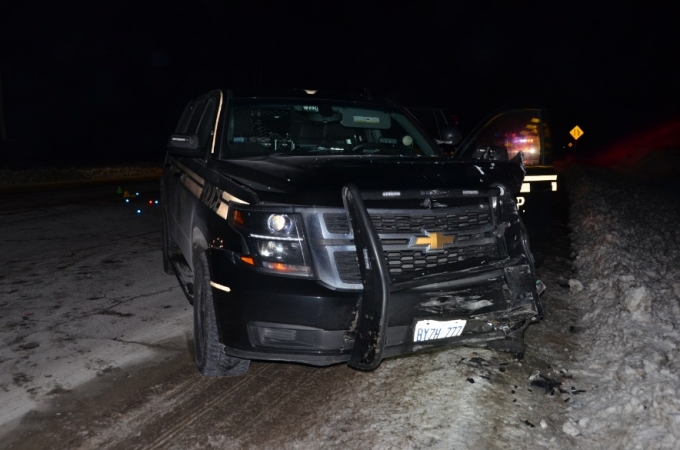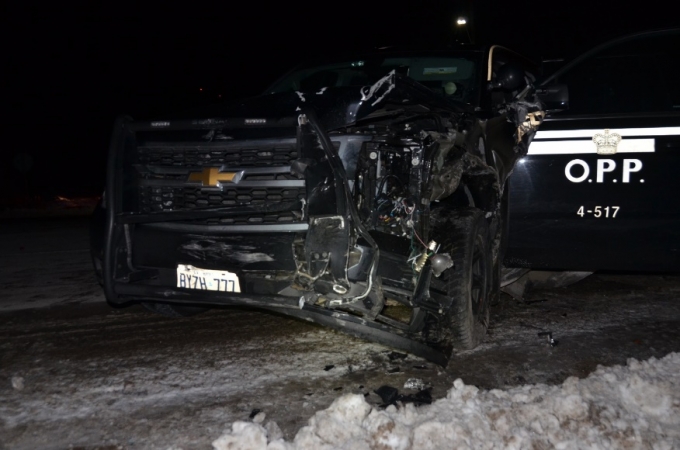SIU Director’s Report - Case # 17-PVI-371
Warning:
This page contains graphic content that can shock, offend and upset.
Contents:
Mandate of the SIU
The Special Investigations Unit is a civilian law enforcement agency that investigates incidents involving police officers where there has been death, serious injury or allegations of sexual assault. The Unit’s jurisdiction covers more than 50 municipal, regional and provincial police services across Ontario.
Under the Police Services Act, the Director of the SIU must determine based on the evidence gathered in an investigation whether an officer has committed a criminal offence in connection with the incident under investigation. If, after an investigation, there are reasonable grounds to believe that an offence was committed, the Director has the authority to lay a criminal charge against the officer. Alternatively, in all cases where no reasonable grounds exist, the Director does not lay criminal charges but files a report with the Attorney General communicating the results of an investigation.
Under the Police Services Act, the Director of the SIU must determine based on the evidence gathered in an investigation whether an officer has committed a criminal offence in connection with the incident under investigation. If, after an investigation, there are reasonable grounds to believe that an offence was committed, the Director has the authority to lay a criminal charge against the officer. Alternatively, in all cases where no reasonable grounds exist, the Director does not lay criminal charges but files a report with the Attorney General communicating the results of an investigation.
Information restrictions
Freedom of Information and Protection of Privacy Act (“FIPPA”)
Pursuant to section 14 of FIPPA (i.e., law enforcement), certain information may not be included in this report. This information may include, but is not limited to, the following:- Confidential investigative techniques and procedures used by law enforcement agencies; and
- Information whose release could reasonably be expected to interfere with a law enforcement matter or an investigation undertaken with a view to a law enforcement proceeding.
- Subject Officer name(s);
- Witness Officer name(s);
- Civilian Witness name(s);
- Location information;
- Witness statements and evidence gathered in the course of the investigation provided to the SIU in confidence; and
- Other identifiers which are likely to reveal personal information about individuals involved in the investigation.
Personal Health Information Protection Act, 2004 (“PHIPA”)
Pursuant to PHIPA, any information related to the personal health of identifiable individuals is not included. Other proceedings, processes, and investigations
Information may have also been excluded from this report because its release could undermine the integrity of other proceedings involving the same incident, such as criminal proceedings, coroner’s inquests, other public proceedings and/or other law enforcement investigations.Mandate engaged
The Unit’s investigative jurisdiction is limited to those incidents where there is a serious injury (including sexual assault allegations) or death in cases involving the police.
“Serious injuries” shall include those that are likely to interfere with the health or comfort of the victim and are more than merely transient or trifling in nature and will include serious injury resulting from sexual assault. “Serious Injury” shall initially be presumed when the victim is admitted to hospital, suffers a fracture to a limb, rib or vertebrae or to the skull, suffers burns to a major portion of the body or loses any portion of the body or suffers loss of vision or hearing, or alleges sexual assault. Where a prolonged delay is likely before the seriousness of the injury can be assessed, the Unit should be notified so that it can monitor the situation and decide on the extent of its involvement.
This report relates to the SIU’s investigation into the serious injury sustained by a 25-year-old woman involved in a collision with a police vehicle.
“Serious injuries” shall include those that are likely to interfere with the health or comfort of the victim and are more than merely transient or trifling in nature and will include serious injury resulting from sexual assault. “Serious Injury” shall initially be presumed when the victim is admitted to hospital, suffers a fracture to a limb, rib or vertebrae or to the skull, suffers burns to a major portion of the body or loses any portion of the body or suffers loss of vision or hearing, or alleges sexual assault. Where a prolonged delay is likely before the seriousness of the injury can be assessed, the Unit should be notified so that it can monitor the situation and decide on the extent of its involvement.
This report relates to the SIU’s investigation into the serious injury sustained by a 25-year-old woman involved in a collision with a police vehicle.
The Investigation
Notification of the SIU
At approximately 8:03 p.m. on Friday, December 22, 2017, the Ontario Provincial Police (OPP) notified the SIU of the serious injury sustained by the Complainant. The OPP reported a motor vehicle collision (MVC) involving an OPP cruiser at the intersection of Highway 17 and Trout Pond Road in the Township of Bonfield. The collision occurred at 5:30 p.m., when the SO, who was travelling eastbound on Highway 17, collided with the Complainant, who was turning left from Trout Pond Road to go west toward North Bay. Also in the Complainant’s vehicle were CW #1 and a second passenger. All parties including the officer went to hospital for examination.
At 11:38 p.m., the OPP advised that the only injury was to the Complainant, who had been diagnosed with two fractured ribs. Both vehicles were secured in the Forensic Identification Service (FIS) garage at the North Bay OPP detachment for examination by the SIU.
The Team
Number of SIU Investigators assigned: 2 Number of SIU Forensic Investigators assigned: 1
Number of SIU Collision Reconstructionist assigned: 1 (peer reviewed the report authored by the OPP Reconstructionist)
Complainant:
25-year-old female interviewed, medical records obtained and reviewedCivilian Witnesses
CW #1 Interviewed CW #2 Interviewed
CW #3 Failed to attend for pre-arranged interview or to respond to voicemail messages left thereafter
Witness Officers
There were no police officers witness to the incident.Subject Officers
The SO Interviewed, notes received and reviewed Incident Narrative
On December 22, 2017 at approximately 5:15 p.m., the Complainant was operating a Buick motor vehicle northbound on Trout Pond Road in the Township of Bonfield. Also in the vehicle were her mother, CW #1, and her sister (a child), who was in a booster seat in the back. The Complainant stopped at the intersection with Highway 17, intending to make a left turn to proceed westbound on Highway 17 towards North Bay.
The SO, who was operating a police vehicle with subdued markings, was travelling eastbound on Highway 17 at the same time. The SO was responding to a call for service in the Township of Bonfield. The SO did not have the emergency lighting system or siren on his police vehicle activated. There were other vehicles eastbound on Highway 17. Highway 17 has two eastbound lanes at this location. The SO was in the passing lane and the other vehicles were in the curb lane. The Complainant’s vehicle entered the intersection making a left turn from Trout Pond Road onto Highway 17 when it was struck by the OPP vehicle, which was travelling straight through the intersection.
The airbag in the Complainant’s vehicle was deployed, but due to the age of the vehicle, no technical information could be obtained. The airbag in the OPP vehicle did not deploy. The Airbag Control Module (ACM) from the OPP vehicle was retrieved and analyzed. Data from the ACM indicated that the OPP vehicle was traveling at a speed of 135 km/h prior to the collision. Highway 17 has a posted speed limit of 90 km/h at this location.
Nature of Injuries / Treatment
The Complainant was examined at hospital and diagnosed with fractures to the 10th and 11th ribs on the left side.
The SO, who was operating a police vehicle with subdued markings, was travelling eastbound on Highway 17 at the same time. The SO was responding to a call for service in the Township of Bonfield. The SO did not have the emergency lighting system or siren on his police vehicle activated. There were other vehicles eastbound on Highway 17. Highway 17 has two eastbound lanes at this location. The SO was in the passing lane and the other vehicles were in the curb lane. The Complainant’s vehicle entered the intersection making a left turn from Trout Pond Road onto Highway 17 when it was struck by the OPP vehicle, which was travelling straight through the intersection.
The airbag in the Complainant’s vehicle was deployed, but due to the age of the vehicle, no technical information could be obtained. The airbag in the OPP vehicle did not deploy. The Airbag Control Module (ACM) from the OPP vehicle was retrieved and analyzed. Data from the ACM indicated that the OPP vehicle was traveling at a speed of 135 km/h prior to the collision. Highway 17 has a posted speed limit of 90 km/h at this location.
Nature of Injuries / Treatment
The Complainant was examined at hospital and diagnosed with fractures to the 10th and 11th ribs on the left side.Evidence
The Scene
The collision occurred in the intersection of Highway 17 and Trout Pond Road near the Community of Rutherglen, in the Township of Bonfield. Traffic on Trout Pond Road approaching Highway 17 is governed by a stop sign. There are no traffic controls governing vehicles travelling on Highway 17 at this location. Photos of the collision scene were taken by the OPP and provided to the SIU.
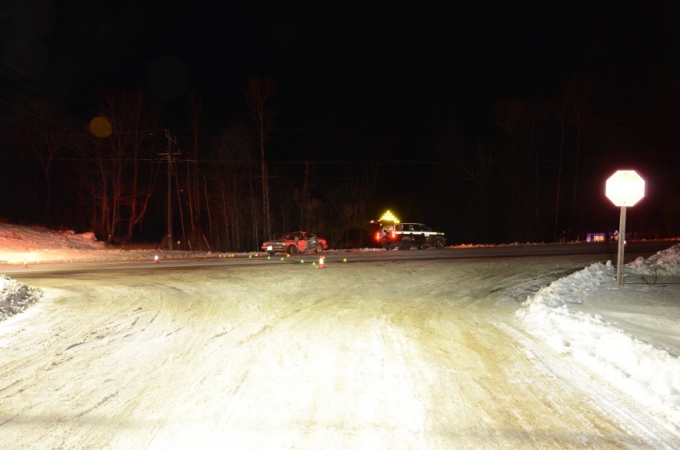
Physical Evidence
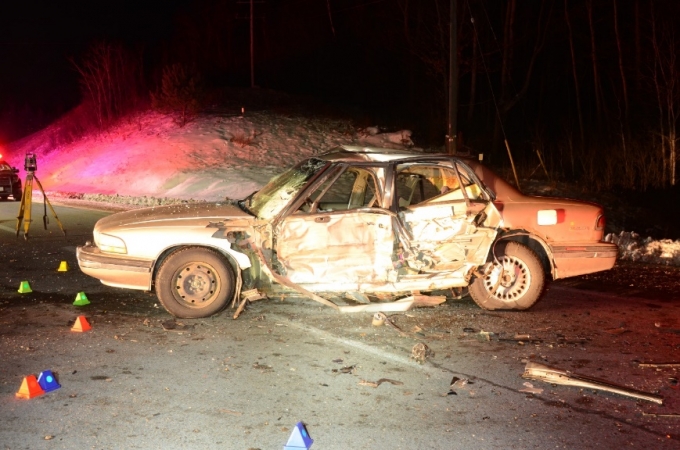
Expert Evidence
OPP Collision Reconstruction Report:
The report indicated that the OPP vehicle’s speed was above 100 km/h for approximately 26 seconds prior to the collision. The OPP vehicle’s speed was above 130 km/h for about 8 seconds according to the Mobile for Public Safety (MPS) Global Positioning Data (GPS) prior to slowing upon approach of the point of impact. [1]
The report concluded the following:
- The OPP vehicle was traveling eastbound on Highway 17 approaching Trout Pond Road. At the same time, the Buick (the Complainant’s motor vehicle) was on Trout Pond Road turning left (west) onto Highway 17;
- The OPP vehicle had the right of way traveling on the through highway within a passing lane;
- The Complainant’s vehicle had to yield the right of way to the OPP vehicle due to the stop sign;
- The operator of the Buick had a minimum of 6 seconds to observe the OPP vehicle and react;
- The OPP vehicle was travelling at approximately 57 km/h at the point of impact;
- The Buick was travelling at approximately 48 km/h at the point of impact; and
- The amount of time it would have taken the Complainant’s vehicle to accelerate from a stopped position to the speed at the point of impact speed was the same amount of time that the brakes were activated on the OPP vehicle, which was approximately 3.5 seconds.
Video/Audio/Photographic Evidence
Photos of the collision scene taken by the OPP were obtained and reviewed.Forensic Evidence
No submissions were made to the Centre of Forensic Sciences. Materials obtained from Police Service
Upon request, the SIU obtained and reviewed the following materials and documents from the OPP:- Computer Aided Dispatch (CAD) Data Map for the SO’s police vehicle;
- CAD Data Table for the SO’s police vehicle;
- CAD Radio Playlist;
- Event Chronology;
- General Occurrence Report;
- GPS Data Map for the SO’s police vehicle;
- GPS Data Table for the SO’s police vehicle;
- Notes of the SO;
- Occurrence Summary;
- OPP Collision Reconstruction Report;
- OPP Collision Scene Photos;
- OPP Communications Recording;
- OPP Vehicle GPS and CAD Data with Rough Calculations;
- OPP Witness Statement for the Complainant and CW #s 1-3; and
- Technical Collision Reconstruction 24 Hr Notification Report.
The SIU also obtained and reviewed the following material:
- ACM data; and
- Medical Record of the Complainant relating to this incident.
Relevant Legislation
Section 249, Criminal Code -- Dangerous operation of motor vehicles
249 (1) Every one commits an offence who operates
(3) Every one who commits an offence under subsection (1) and thereby causes bodily harm to any other person is guilty of an indictable offence and liable to imprisonment for a term not exceeding ten years.(a) a motor vehicle in a manner that is dangerous to the public, having regard to all the circumstances, including the nature, condition and use of the place at which the motor vehicle is being operated and the amount of traffic that at the time is or might reasonably be expected to be at that place…
Section 128, Highway Traffic Act – Rate of speed
128 (1) No person shall drive a motor vehicle at a rate of speed greater than,
(a) 50 kilometres per hour on a highway within a local municipality or within a built-up area;(b) Despite clause (a), 80 kilometres per hour on a highway, not within a built-up area, that is within a local municipality that had the status of a township on December 31, 2002 and, but for the enactment of the Municipal Act, 2001, would have had the status of a township on January 1, 2003, if the municipality is prescribed by a regulation;(c) 80 kilometres per hour on a highway designated by the Lieutenant Governor in Council as a controlled access highway under the Public Transportation and Highway Improvement Act, whether or not the highway is within a local municipality or built-up area;(d) The rate of speed prescribed for motor vehicles on a highway in accordance with subsection (2), (5), (6), (6.1) or (7);(e) The maximum rate of speed set under subsection (10) and posted in a construction zone designated under subsection (8) or (8.1); or(f) The maximum rate of speed posted on a highway or portion or a highway pursuant to section 128.0.1 2005, c.26, Sched. A, s. 17 (1); 2006, c. 11, Sched. B, s. 6 (2); 2006, c. 32, Sched D, s. 4 (1).
(13) The speed limits prescribed under this section or any regulation or by-law passed under this section do not apply to,
(b) a police department vehicle being used in the lawful performance of a police officers’ duties;
Section 136, Highway Traffic Act – Stop at through highway
136 (1) Every driver or street car operator approaching a stop sign at an intersection,
(a) shall stop his or her vehicle or street car at a marked stop line or, if none, then immediately before entering the nearest crosswalk or, if none, then immediately before entering the intersection; and(b) shall yield the right of way to traffic in the intersection or approaching the intersection on another highway so closely that to proceed would constitute an immediate hazard and, having yielded the right of way, may proceed.
Section 141 (5), Highway Traffic Act – Left turn, across path of approaching vehicle
(5) No driver or operator of a vehicle in an intersection shall turn left across the path of a vehicle approaching from the opposite direction unless he or she has afforded a reasonable opportunity to the driver or operator of the approaching vehicle to avoid a collision.
Analysis and Director's Decision
On December 22, 2017, at 4:50:35 p.m., a 911 call was received by the Ontario Provincial Police (OPP) communications centre requesting police assistance in the area of Guay Road in the Community of Bonfield. The caller indicated that a motor vehicle had gone into the ditch and that the occupants were behaving suspiciously and were possibly impaired by drugs. At 4:54:25 p.m., an OPP officer was dispatched to the collision; at 5:01:47 p.m., the dispatcher noted that the SO was also en route to assist.
The SO was operating a black Chevy Tahoe with subdued markings and an emergency lighting system on the dash inside the vehicle and on the grille near the push bars. The SO was en route to the accident scene at just after 5:00 p.m., travelling eastbound on Highway 17. He had not activated either his emergency lighting system or his siren, as the call did not require them.
The Complainant was operating a Buick LeSabre travelling northbound on Trout Pond Road, approaching the stop sign at its intersection with Highway 17, where the Complainant intended to make a left turn onto Highway 17 westbound to head towards North Bay. The Complainant had two occupants in her motor vehicle.
CW #2 was driving two cars behind the SO, travelling eastbound on Highway 17. He estimated that his own speed, and that of the two cars in front of him, including the police SUV, was a steady 95 km/h. CW #2 had followed these two vehicles for some time, and they had maintained the same formation, with all three in the curb lane. CW #2 estimated that the OPP vehicle was approximately 200 metres ahead of his own vehicle.
All vehicles had their headlights activated, and all occupants were wearing their seatbelts. The roads were lightly snow covered and had been plowed, the weather was dark or close to dark, but clear, it was not snowing and the traffic was light. The speed limit on both Highway 17 and Trout Pond Road at this location is a posted 90 km/h.
At approximately 5:15 p.m., the SO was approaching the intersection with Trout Pond Road and pulled into the passing lane on a straight stretch of the highway to pass another motor vehicle, approximately half of a kilometre before the intersection. While he was unaware of the speed of his vehicle, his MPS GPS and CAD data indicated that he was travelling at just over 100 km/h for 26 seconds and at approximately 135 km/h for about eight seconds prior to entering the intersection with Trout Pond Road.
The Complainant was stopped on Trout Pond Road at the stop sign at Highway 17. She recalled being stopped for a full three seconds and observing that there was no westbound traffic, but that there was traffic coming eastbound. The Complainant observed one vehicle in the curb lane and one in the passing lane; she could only see the headlights of these vehicles, and not the actual vehicles at the time that she made her observation. The Complainant estimated that the vehicle in the passing lane was slightly ahead of that in the curb lane, but they were very close to each other.
The Complainant made a judgment call and pulled out onto Highway 17 to start her left turn; she was of the view that she had sufficient time to complete her turn before the two eastbound vehicles approached.
The SO observed a motor vehicle stopped at the stop sign at Trout Pond Road, as he approached from a distance of roughly 200 to 300 feet. The SO saw the vehicle move forward slightly and believed it was going to stop and wait for traffic to pass. The SO tapped his brakes.
CW #2 described the Complainant’s motor vehicle as pulling out directly in front of the police vehicle, leaving the SO no time to react.
The Complainant indicated that while she initially believed that she had sufficient time to safely complete her left turn, as she crossed the curb lane and entered the passing lane where the SO was driving, she sped up as she realized that the vehicle was coming towards her faster than anticipated. The Complainant believed that the police vehicle swerved partially into the westbound lanes, either because she had startled the driver, or to avoid striking her vehicle. The GPS data on the Complainant’s vehicle indicated that she had accelerated to 48 km/h at the point of impact.
The SO indicated that the stopped vehicle then drove out in front of his vehicle and he initially swerved to the left (into the westbound lanes) and then to the right to try to get around the vehicle. He braked hard to avoid a collision. The GPS data confirmed that the SO had slowed his vehicle to 57 km/h prior to impact.
The GPS data from both vehicles indicated that the SO braked and the Complainant accelerated for approximately 3.5 seconds prior to impact.
At approximately 5:15 p.m., the OPP vehicle driven by the SO collided with the driver’s side front and rear doors of the Buick LeSabre operated by the Complainant.
The Complainant sustained fractures to the tenth and eleventh ribs on her left side (or closest to the driver’s door) while the SO sustained a fracture to his left wrist.
Two civilian witnesses in addition to the Complainant and the SO were interviewed during the course of this investigation; all agree upon the facts as set out above.
Pursuant to section 136 of the Highway Traffic Act (HTA), the onus is on the driver governed by a stop sign to stop his or her vehicle and:
As such, in this factual situation, the Complainant, who was governed by a stop sign while the SO had the right of way, was obligated, after stopping, to yield the right of way to traffic approaching on Highway 17, and not to proceed until it was safe to do so. While the Complainant made a judgment call believing that she had sufficient time to complete her turn, she was in error.
As such, while it is clear that the HTA puts the responsibility onto the driver facing a stop sign to ensure that the way is clear before proceeding, the only question remaining to be determined is whether or not there are reasonable grounds to believe that the SO committed a criminal offence, specifically, whether or not his driving rose to the level of being dangerous and therefore in contravention of s.249 (1) of the Criminal Code and did thereby cause bodily harm contrary to s.249 (3), in that he was operating his motor vehicle in excess of the posted speed limit by some 45 km/h just prior to the collision.
Pursuant to the Supreme Court of Canada in R. v. Beatty, [2008] 1 S.C.R. 49, s.249 requires that the driving be “dangerous to the public, having regard to all of the circumstances, including the nature, condition and use of the place at which the motor vehicle is being operated and the amount of traffic that, at the time, is or might reasonably be expected to be at that place” and the driving must be such that it amounts to “a marked departure from the standard of care that a reasonable person would observe in the accused’s circumstances.”
In applying the reasonable person test, I must consider if the SO’s driving was a marked departure from the standard of care that a reasonable person in his circumstances would observe. As such, I must determine if his driving amounted to a marked departure from that of a police officer, who is exempt from complying with the posted speed limit, pursuant to s. 138 (13), wherein it indicates that:
As such, while the SO was exceeding the posted speed limit of 90 km/h, he was not in contravention of the HTA, as he was both operating a police department vehicle and he was doing so in the lawful performance of his duties, that being responding to a call for police assistance involving a motor vehicle collision.
In assessing the driving of the SO, I have reminded myself of the jurisprudence of the Supreme Court of Canada that I am not to hold police to an unattainable standard of perfection, as enunciated in their decision in R. v. Nasogaluak [2010] 1 S.C.R. 206.
And the subsequent decision in R. v. M.K.M., [1998] O.J. No. 1601, that in certain circumstances, excessive speed alone may be sufficient to establish dangerous driving:
Having fully considered the edicts from our Court of Appeal as to the factors to consider in assessing whether or not I have reasonable grounds to believe that there is sufficient evidence to make out a charge of dangerous driving in this case, I find that I do not.
Taking into account that the only evidence that I have which would support a charge of dangerous driving would be that of a rate of speed which exceeded the posted speed limit, while the SO was responding to a call for assistance, countered by the evidence that the officer was immediately aware that a motor vehicle had entered the intersection in his path, that he immediately braked and attempted evasive manoeuvres in order to avoid a collision, and that there is no evidence, other than mere speed, that the SO’s driving was anything less than compliant with HTA provisions, I must conclude, in the absence of some evidence that the SO was driving in a dangerous manner other than the rate of speed at which he travelled for a brief period of time, that the evidence falls far short of satisfying me that I have reasonable grounds to believe that the actions of the SO amounted to a ‘marked departure’ of the standard of care of a reasonable police officer in these circumstances.
In conclusion, having considered all of the evidence, which is not disputed as between all of the civilian witnesses and the SO, while I find that the driving of the SO may not have attained a level of perfection, I have no hesitation in finding that neither did it rise to the level of being criminal in nature.
The unfortunate collision in which both drivers were injured was not as a direct result of the driving of the SO, nor is there a causal connection between the actions of the SO and the consequent injuries sustained. As such, since I lack the necessary grounds for the laying of criminal charges, none shall issue.
Date: October 18, 2018
Original signed by
Tony Loparco
Director
Special Investigations Unit
The SO was operating a black Chevy Tahoe with subdued markings and an emergency lighting system on the dash inside the vehicle and on the grille near the push bars. The SO was en route to the accident scene at just after 5:00 p.m., travelling eastbound on Highway 17. He had not activated either his emergency lighting system or his siren, as the call did not require them.
The Complainant was operating a Buick LeSabre travelling northbound on Trout Pond Road, approaching the stop sign at its intersection with Highway 17, where the Complainant intended to make a left turn onto Highway 17 westbound to head towards North Bay. The Complainant had two occupants in her motor vehicle.
CW #2 was driving two cars behind the SO, travelling eastbound on Highway 17. He estimated that his own speed, and that of the two cars in front of him, including the police SUV, was a steady 95 km/h. CW #2 had followed these two vehicles for some time, and they had maintained the same formation, with all three in the curb lane. CW #2 estimated that the OPP vehicle was approximately 200 metres ahead of his own vehicle.
All vehicles had their headlights activated, and all occupants were wearing their seatbelts. The roads were lightly snow covered and had been plowed, the weather was dark or close to dark, but clear, it was not snowing and the traffic was light. The speed limit on both Highway 17 and Trout Pond Road at this location is a posted 90 km/h.
At approximately 5:15 p.m., the SO was approaching the intersection with Trout Pond Road and pulled into the passing lane on a straight stretch of the highway to pass another motor vehicle, approximately half of a kilometre before the intersection. While he was unaware of the speed of his vehicle, his MPS GPS and CAD data indicated that he was travelling at just over 100 km/h for 26 seconds and at approximately 135 km/h for about eight seconds prior to entering the intersection with Trout Pond Road.
The Complainant was stopped on Trout Pond Road at the stop sign at Highway 17. She recalled being stopped for a full three seconds and observing that there was no westbound traffic, but that there was traffic coming eastbound. The Complainant observed one vehicle in the curb lane and one in the passing lane; she could only see the headlights of these vehicles, and not the actual vehicles at the time that she made her observation. The Complainant estimated that the vehicle in the passing lane was slightly ahead of that in the curb lane, but they were very close to each other.
The Complainant made a judgment call and pulled out onto Highway 17 to start her left turn; she was of the view that she had sufficient time to complete her turn before the two eastbound vehicles approached.
The SO observed a motor vehicle stopped at the stop sign at Trout Pond Road, as he approached from a distance of roughly 200 to 300 feet. The SO saw the vehicle move forward slightly and believed it was going to stop and wait for traffic to pass. The SO tapped his brakes.
CW #2 described the Complainant’s motor vehicle as pulling out directly in front of the police vehicle, leaving the SO no time to react.
The Complainant indicated that while she initially believed that she had sufficient time to safely complete her left turn, as she crossed the curb lane and entered the passing lane where the SO was driving, she sped up as she realized that the vehicle was coming towards her faster than anticipated. The Complainant believed that the police vehicle swerved partially into the westbound lanes, either because she had startled the driver, or to avoid striking her vehicle. The GPS data on the Complainant’s vehicle indicated that she had accelerated to 48 km/h at the point of impact.
The SO indicated that the stopped vehicle then drove out in front of his vehicle and he initially swerved to the left (into the westbound lanes) and then to the right to try to get around the vehicle. He braked hard to avoid a collision. The GPS data confirmed that the SO had slowed his vehicle to 57 km/h prior to impact.
The GPS data from both vehicles indicated that the SO braked and the Complainant accelerated for approximately 3.5 seconds prior to impact.
At approximately 5:15 p.m., the OPP vehicle driven by the SO collided with the driver’s side front and rear doors of the Buick LeSabre operated by the Complainant.
The Complainant sustained fractures to the tenth and eleventh ribs on her left side (or closest to the driver’s door) while the SO sustained a fracture to his left wrist.
Two civilian witnesses in addition to the Complainant and the SO were interviewed during the course of this investigation; all agree upon the facts as set out above.
Pursuant to section 136 of the Highway Traffic Act (HTA), the onus is on the driver governed by a stop sign to stop his or her vehicle and:
… yield the right of way to traffic in the intersection or approaching the intersection on another highway so closely that to proceed would constitute an immediate hazard and, having yielded the right of way, may proceed.
As such, in this factual situation, the Complainant, who was governed by a stop sign while the SO had the right of way, was obligated, after stopping, to yield the right of way to traffic approaching on Highway 17, and not to proceed until it was safe to do so. While the Complainant made a judgment call believing that she had sufficient time to complete her turn, she was in error.
As such, while it is clear that the HTA puts the responsibility onto the driver facing a stop sign to ensure that the way is clear before proceeding, the only question remaining to be determined is whether or not there are reasonable grounds to believe that the SO committed a criminal offence, specifically, whether or not his driving rose to the level of being dangerous and therefore in contravention of s.249 (1) of the Criminal Code and did thereby cause bodily harm contrary to s.249 (3), in that he was operating his motor vehicle in excess of the posted speed limit by some 45 km/h just prior to the collision.
Pursuant to the Supreme Court of Canada in R. v. Beatty, [2008] 1 S.C.R. 49, s.249 requires that the driving be “dangerous to the public, having regard to all of the circumstances, including the nature, condition and use of the place at which the motor vehicle is being operated and the amount of traffic that, at the time, is or might reasonably be expected to be at that place” and the driving must be such that it amounts to “a marked departure from the standard of care that a reasonable person would observe in the accused’s circumstances.”
In applying the reasonable person test, I must consider if the SO’s driving was a marked departure from the standard of care that a reasonable person in his circumstances would observe. As such, I must determine if his driving amounted to a marked departure from that of a police officer, who is exempt from complying with the posted speed limit, pursuant to s. 138 (13), wherein it indicates that:
(13) The speed limits prescribed under this section or any regulation or by-law passed under this section do not apply to,
(b) a police department vehicle being used in the lawful performance of a police officers’ duties.
In assessing the driving of the SO, I have reminded myself of the jurisprudence of the Supreme Court of Canada that I am not to hold police to an unattainable standard of perfection, as enunciated in their decision in R. v. Nasogaluak [2010] 1 S.C.R. 206.
As well as their pronouncement in R. v. Roy (2012), 281 C.C.C. (3d) 433, wherein the Supreme Court of Canada held that a simple misjudgment could not reasonably support an inference of a marked departure, as follows:
And further:
I have also carefully considered the decision of our Court of Appeal in R. v. Pezzo, [1972] O.J. No. 965, that excessive speed alone does not necessarily equate with dangerous driving. The following is an excerpt from that case, in which the Court found that the offence of dangerous driving was not made out despite the extremely high rate of speed at which the Appellant was travelling at the time:
A fundamental point in Beatty is that dangerous driving is a serious criminal offence. It is, therefore, critically important to ensure that the fault requirement for dangerous driving has been established. Failing to do so unduly extends the reach of the criminal law and wrongly brands as criminals those who are not morally blameworthy. The distinction between a mere departure, which may support civil liability, and the marked departure required for criminal fault is a matter of degree. The trier of fact must identify how and in what way the departure from the standard goes markedly beyond mere carelessness.
And further:
Simple carelessness, to which even the most prudent drivers may occasionally succumb, is generally not criminal. As noted earlier, Charron J., for the majority in Beatty, put it this way: "If every departure from the civil norm is to be criminalized, regardless of the degree, we risk casting the net too widely and branding as criminals persons who are in reality not morally blameworthy" (para. 34). The Chief Justice expressed a similar view: "Even good drivers are occasionally subject to momentary lapses of attention. These may, depending on the circumstances, give rise to civil liability, or to a conviction for careless driving. But they generally will not rise to the level of a marked departure required for a conviction for dangerous driving" (para. 71).
I have also carefully considered the decision of our Court of Appeal in R. v. Pezzo, [1972] O.J. No. 965, that excessive speed alone does not necessarily equate with dangerous driving. The following is an excerpt from that case, in which the Court found that the offence of dangerous driving was not made out despite the extremely high rate of speed at which the Appellant was travelling at the time:
With respect to the dangerous driving there is very little evidence. The Crown gave particulars of the dangerous driving and restricted itself to excessive speed. My brother Arnup and I are of the opinion that on the scanty evidence presented it would be unsafe to maintain a conviction. The learned trial Judge said:
• "On all the evidence before me I find that you took this car, had it in your possession, stole it, were driving it. The car tipped over, on the evidence before me, after a skid mark of some 98 feet, flipped over on its back ... for another 42 feet skid mark which indicates a great deal of speed, a collision with the wall. On all the evidence before me I find you guilty of the charge of theft of a motor vehicle and dangerous driving."
With respect to the learned trial Judge we are not satisfied that the evidence clearly discloses that the appellant was driving in such a manner that the driving can be characterized as dangerous driving within the meaning of the relevant section of the Code. We would accordingly allow the appeal against conviction and direct an acquittal on the charge of dangerous driving.
And the subsequent decision in R. v. M.K.M., [1998] O.J. No. 1601, that in certain circumstances, excessive speed alone may be sufficient to establish dangerous driving:
Depending on the context in which it occurred, excessive speed can amount to a marked departure from the standard of care of a prudent driver. Here the context included the following: the accident occurred on a busy highway in a built up area of Mississauga, and just before the accident the appellant had been driving aggressively and engaging in "horseplay" on the road with her co-accused. Although their estimates of the appellant's driving speed varied, all of the independent witnesses testified that she was driving too fast. The evidence of … all supported the trial judge's conclusion that the appellant was driving well above the speed limit and too quickly to avoid any unexpected occurrence on the highway. Indeed, Miss Black gave evidence that the appellant lost control of her car because she was driving too fast.
Having fully considered the edicts from our Court of Appeal as to the factors to consider in assessing whether or not I have reasonable grounds to believe that there is sufficient evidence to make out a charge of dangerous driving in this case, I find that I do not.
Taking into account that the only evidence that I have which would support a charge of dangerous driving would be that of a rate of speed which exceeded the posted speed limit, while the SO was responding to a call for assistance, countered by the evidence that the officer was immediately aware that a motor vehicle had entered the intersection in his path, that he immediately braked and attempted evasive manoeuvres in order to avoid a collision, and that there is no evidence, other than mere speed, that the SO’s driving was anything less than compliant with HTA provisions, I must conclude, in the absence of some evidence that the SO was driving in a dangerous manner other than the rate of speed at which he travelled for a brief period of time, that the evidence falls far short of satisfying me that I have reasonable grounds to believe that the actions of the SO amounted to a ‘marked departure’ of the standard of care of a reasonable police officer in these circumstances.
In conclusion, having considered all of the evidence, which is not disputed as between all of the civilian witnesses and the SO, while I find that the driving of the SO may not have attained a level of perfection, I have no hesitation in finding that neither did it rise to the level of being criminal in nature.
The unfortunate collision in which both drivers were injured was not as a direct result of the driving of the SO, nor is there a causal connection between the actions of the SO and the consequent injuries sustained. As such, since I lack the necessary grounds for the laying of criminal charges, none shall issue.
Date: October 18, 2018
Original signed by
Tony Loparco
Director
Special Investigations Unit
Endnotes
- 1) The MPS is one of three segments relating to GPS data (1. GPS, 2. MPS, 3. CAD) and provides the most detailed analysis. [Back to text]
Note:
The signed English original report is authoritative, and any discrepancy between that report and the French and English online versions should be resolved in favour of the original English report.

